Exhibitor's Campaign Book from MGM "Where Eagles Dare", 1968 |
Read more at in70mm.com The 70mm Newsletter |
| Written by: MGM, retyped for in70mm.com by Anders M Olsson, Sweden | Date: 04.10.2023 |
Took some doing before they could "blow up" historic castle in movie |
|
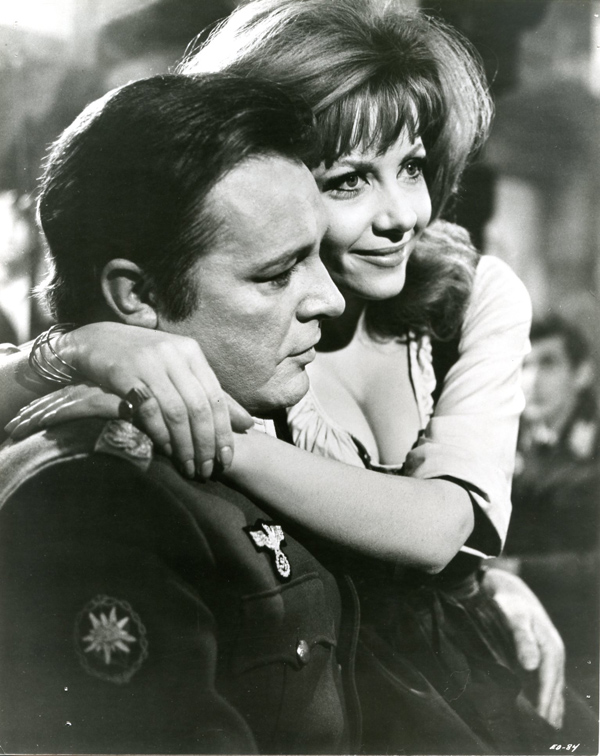 Richard Burton, posing as a Nazi officer, and Ingrid Pitt as a beer
tavern barmaid, are two of the conspirators in MGM's suspenseful drama,
"Where Eagles Dare," revolving about an Allied team parachuted into the
Bavarian Alps during World War II. Clint Eastwood and Mary Ure enact
fellow-adventurers in the explosive story, filmed on spectacular locations
high in the Austrian Alps in Panavision and Metrocolor. Picture: MGM Richard Burton, posing as a Nazi officer, and Ingrid Pitt as a beer
tavern barmaid, are two of the conspirators in MGM's suspenseful drama,
"Where Eagles Dare," revolving about an Allied team parachuted into the
Bavarian Alps during World War II. Clint Eastwood and Mary Ure enact
fellow-adventurers in the explosive story, filmed on spectacular locations
high in the Austrian Alps in Panavision and Metrocolor. Picture: MGMStill ED-84 Where Eagles Dare Mat 1-L One of Europe's oldest and most historic castles, after surviving fire and siege for nearly nine centuries, almost had its movie "debut" cancelled when a proud local citizenry became upset over its film fate. The castle is the majestic rock edifice, Schloss Hohenwerfen, perched high atop a mountain peak in the Austrian Alps near the village of Werfen, some 25 miles from Salzburg. It was built in the year 1077 by Archhishop Gebhard of Salzburg. Its lofty location made it an easy choice among dozens of old castles inspected to play a key part in MGM's adventure-drama, "Where Eagles Dare," starring Richard Burton, Clint Eastwood and Mary Ure. It ideally fitted novelist Alistair MacLean's description of his screenplay's castle--"impregnable and inaccessible." The hitch came when a Salzburg newspaper reported how the movie story called for the castle to be set afire and blown up by a daring World War II team led by Burton and Eastwood. A special citizens' committee promptly called on producer Elliott Kastner, intent on withdrawing permission for use of their famous landmark. • Go to An Evening with Derren Nesbitt • Go to "Where Eagles Dare" - 40th Anniversary 1969 - 2009 "After what it had been through in the past, the Austrian gentlemen weren't about to see their castle destroyed for the sake of a movie," Kastner recalled. "Some of the older men among them remembered how fire swept through it in 1931. Only its great bell and belltower and the naked walls were left. It took several years to restore." It required several hours and considerable persuasion for Kastner to convince the committee that Schloss Hohenwerfen would remain in the same condition after their filming as before, thanks to a crack team of special effects and movie action experts.. "It would have been impossible without the outstanding men--Americans, Englishmen and Austrians--we had working with us," said Kastner. "Like Yakima Canutt, they were all top men in their field." |
More in 70mm reading: An Evening with Derren Nesbitt "Where Eagles Dare" - 40th Anniversary 1969 - 2009 "Where Eagles Dare" - Cinema Retro ‘Movie Classics’ Special “Broadsword Calling Danny Boy” Widescreen Weekend Report 2009 in70mm.com's Library Presented on the big screen in 7OMM Peripheral Vision, Scopes, Dimensions and Panoramas |
 Schloss Hohenwerfen
aka. "The Castle of Eagles" overlooking the small town of Werfen,
19.07.2007. Picture: Thomas Hauerslev Schloss Hohenwerfen
aka. "The Castle of Eagles" overlooking the small town of Werfen,
19.07.2007. Picture: Thomas HauerslevCanutt, who staged the action scenes for "Where Eagles Dare," has gained a reputation as the screen's foremost action-expert with such films as "BenHur," "Mogambo," "Spartacus" and "El Cid," among others. He long since had learned to handle an item of such historical significance as Schloss Hohenwerfen with great precautionary care even while racking it with explosions for a solid week. "It's impossible to conceive of man in the eleventh century building such an immense structure on top of that peak," said Kastner. "We had a hard time moving our company and equipment by jeep up a steep, winding, one-way road." From its high perch, Schloss Hohenwerfen overlooks and in earlier times controlled the vast Salzach valley spread out thousands of feet below. Unbelievably, it was once captured by farmers of the valley in the Farmers' War of 1525. Before and since, it has been the home and stronghold of countless archbishops, a cardinal, several Austrian counts and royal dukes. Early in the 19th century there was thought of turning it into a prison, then of demolishing it. Instead, it was stripped of its armaments, its garrison was moved and it fell into disuse. Several years later, Emperor Franz I ordered it repaired and maintained in good order. In 1938, after it had been restored following the fire, it became a school for the National Socialistic German Workers Party (NSDAP). After World War II, it was transformed into an office and school for the Austrian police. The police officers and young trainees are still there. During the filming of "Where Eagles Dare," they kept an anxious eye on the strange goings-on, obviously aware of their castle's proud heritage. |
|
324 Persons Invade Cold Austrian Alps |
|
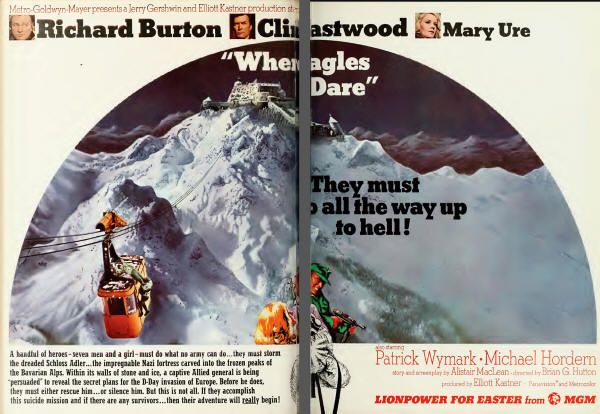 North
America Boxoffice double page advert for "Where Eagles Dare". Paul
Rayton Archive. North
America Boxoffice double page advert for "Where Eagles Dare". Paul
Rayton Archive.Filming the screen's latest epic-adventure motion picture turned into an incredible adventure itself for the 324 men and women invading the snow-covered Austrian Alps. The record-sized movie troupe filming MGM's "Where Eagles Dare" encountered blizzards, four-foot snow drifts, avalanches and sub-zero temperatures during a location without precedent for its physical challenge. The company, headed by stars Richard Burton, Clint Eastwood and Mary Ure, was made up of Americans, Britishers, Austrians and Germans. At times they made their way through deep, virgin snow, carrying cameras and equipment onto high slopes above the village of Werfen, 25 miles from Salzburg. To reach a base camp below the film site, they drove by jeep and mini-bus up steep and narrow roads repeatedly cleared by snowplows. Sometimes the roads couldn't be cleared and the troupe was forced to lower sites for alternate scenes. Some scenes were filmed in the midst of raging blizzards. Twice the main road from Salzburg, headquarters for the "Where Eagles Dare" company, was closed by avalanches. Local residents called it "an unusual winter." So did the movie-making visitors! |
|
Film career and family? No problem at all in life of actress Mary Ure |
|
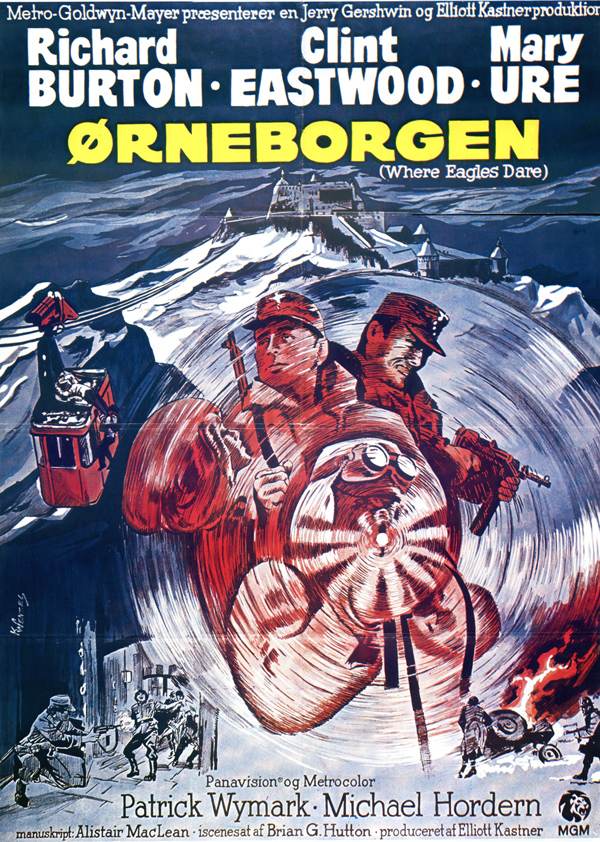 Mary Ure plays an adventurous girl who joins Richard Burton and Clint
Eastwood in a danger-filled mission in "Where Eagles Dare" in which the trio
are parachuted into World War II Germany. The thrill-packed MGM drama was
filmed from a story and screenplay by Alistair MacLean and filmed on
locations in the Austrian Alps in Panavision and Metrocolor. Mary Ure plays an adventurous girl who joins Richard Burton and Clint
Eastwood in a danger-filled mission in "Where Eagles Dare" in which the trio
are parachuted into World War II Germany. The thrill-packed MGM drama was
filmed from a story and screenplay by Alistair MacLean and filmed on
locations in the Austrian Alps in Panavision and Metrocolor. Danish "Where Eagles Dare" release poster from MGM, 1969. How does a woman—-a striking blonde woman with a flourishing career-—cope with all that and manage to raise a family of seven children? Easily, if she happens to be Mary Ure. "There doesn't seem to be any unusual problem about it," commented the actress, whose numerous film and stage honors have included an Academy Award nomination and a trophy as Britain's "Best Actress of the Year." Part of the answer may be found in her added explanation, spoken with casualness, "We have a nice old home in the country with 30 rooms. And we have several acres where we grow all our own vegetables." Miss Ure and her husband, the noted writer and actor Robert Shaw, also have an apple orchard, a swimming pool of near Olympic proportions and a tennis court at their home in Amersham, about 25 miles from London. "Parts of our home date back to the 14th century," said Miss Ure, "but it really isn't of any period. It has been added to at intervals." Her favorite spots are the pool and tennis court. "I can't wait to get home after a day at the studio and have a swim," she said. "Between swimming and tennis I never have to worry about my weight." Her recent film activity also has helped her to maintain a slender figure that would be the envy of any teenager. Co-starring with Richard Burton and Clint Eastwood in MGM's adventure-drama, "Where Eagles Dare," took her high into the Austrian Alps for the most strenuous experience of her life. "It was physically exhausting and cold beyond belief in all that snow," she declared. "At times we actually worked in blizzards. For one scene I had to wade waist-deep across a slope on which the snow was completely unmarked—-just a vast expanse of white as far as one could see. But it also was very beautiful when we weren't blowing up a castle or shooting it out with the enemy." In "Where Eagles Dare," Miss Ure plays a girl in love with Burton, a fellow-adventurer leading an Allied team on a spectacular mission behind World War II enemy lines. "I even did some of the shooting," she said. "It was the first time I had ever fired a gun and I must confess the idea frightened me a bit. Richard and Clint both were very good about helping me. They're old hands at that sort of thing." |
|
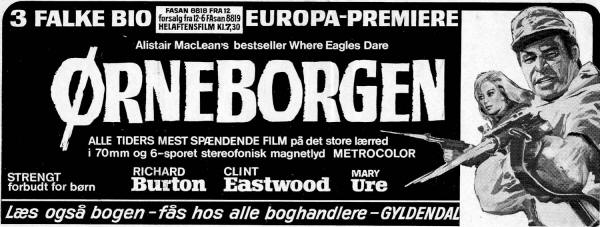 Advert
featuring May Ure from the Europe premiere at the 3 Falke Bio Todd-AO Theatre in
Copenhagen, Denmark where the film played from 20.01.1969 until 05.06.1969
in 70mm and 6-track stereophonic sound. Advert
featuring May Ure from the Europe premiere at the 3 Falke Bio Todd-AO Theatre in
Copenhagen, Denmark where the film played from 20.01.1969 until 05.06.1969
in 70mm and 6-track stereophonic sound. During the Austrian location, the actress and the entire Shaw family lived in a quaint chalet on the outskirts of Salzburg. "The rest of the company stayed in hotels in the city," Miss Ure stated, "but, of course, we were the only ones with seven youngsters along. On the days when I was working, Robert took care of the children and wrote on his new novel. When I didn't work, we all went skiing on a mountain slope right behind our chalet." Doing things together seems to be a custom with the Shaws. Professionally, Miss Ure and her husband have joined their talents in two motion pictures, one stage play and a television show. While they don't work together as frequently as Miss Ure's co-star (Burton and Elizabeth Taylor have teamed in eight films during the past five years), the Shaws thus far have seen to it that their respective careers haven't caused any lengthy separations. |
|
The Life of a Stunt Man |
|
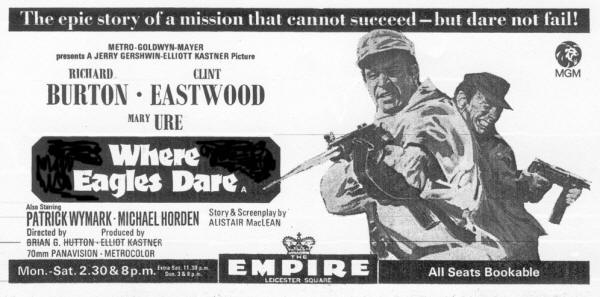 Release
at the Empire, London (UK), 22.01.1969 - 11.03.1069 Release
at the Empire, London (UK), 22.01.1969 - 11.03.1069Yakima Canutt, who has staged such spectacular action scenes as the chariot race in "Ben-Hur," the gorilla hunt in "Magambo" and the battles of "Spartacus," admitted to one of his biggest scares while filming parachute drops into the snow-covered Austrian Alps for a scene in MGM's adventure-drama, "Where Eagles Dare," starring Richard Burton, Clint Eastwood and Mary Ure. Recounted the veteran Canutt: "One parachutist landed high in a pine tree and a second climbed up 80 feet to untangle and rescue him. If the wind had snapped that tree, they both would have been killed." |
|
Clint Discards Horse In Tense Adventure Film |
|
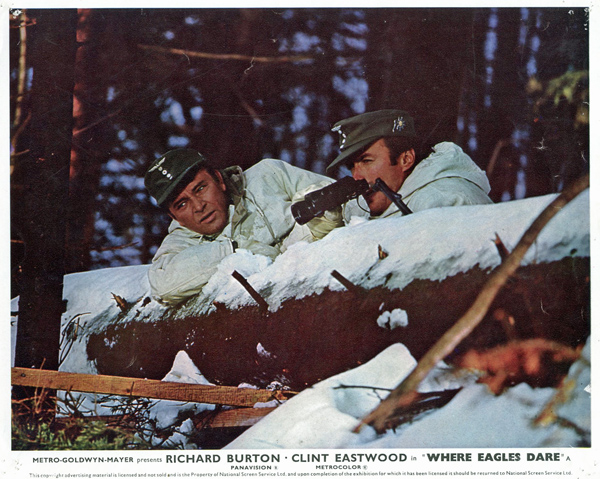 Richard
Burton and Clint Eastwood in MGM's adventure-drama, "Where Eagles Dare".
Picture: MGM Richard
Burton and Clint Eastwood in MGM's adventure-drama, "Where Eagles Dare".
Picture: MGMIt first became evident in the most unexpected of places - the Austrian Alps. Clint Eastwood, the erstwhile pride of the prairies, had discarded his trusty steed. His boots and saddle, his poncho and western hat were put in limbo. So was his six-shooter. The lanky star had traded in the lot after seven years as TV's "Rawhide" star and his three "Dollar" movies. But he figured he made a good swap. He now stars with Richard Burton and Mary Ure in the most important, highest-budgeted picture of his career, MGM's "Where Eagles Dare." An adventure movie on the epic scale, it casts Eastwood as a rugged American Ranger, assigned to an Allied team led by Burton on an incredible mission behind World War II enemy lines. Its filming became an adventure in itself for the stars. In violent Alpine weather that included blizzards and avalanches they often found themselves emoting in sub-zero temperatures and howling winds that drowned out their dialogue. On more than one occasion the camera froze. Another had to be hauled to the location site by sled across vast stretches of snow. But the screenplay, written by famed novelist Alistair MacLean, provided them with one means of keeping warm. It called for action, such as running around blowing up everything in sight, gunning down Nazis by the score, and attempting a fantastic escape. It was during this "getaway" that Eastwood was given a substitute for his trusty steed of old--a motorcycle of World War II German army vintage, complete with sidecar. Burton became his somewhat uneasy passenger. "Can you really run this thing?" Burton asked, when he climbed in for the first time. "Well, I think so," drawled Eastwood. "It's different from those I've ridden around home in California, but it's a motorcycle." When both came through unscathed and still upright after a wild race over narrow, icy mountain roads in heavily falling snow, Eastwood admitted the difference was greater than he had expected. "I hadn't driven one of these things through a snow storm before," he said. "It was really coming down." A few weeks later, in London, where interior scenes for "Where Eagles Dare" were filmed, the handsome, six-foot, four-inch actor bought a new British model to take home to California. When not before the cameras, he made good use of it by racing on London's Brand's Hatch track or touring the city's historical sights. "Just what a fellow needs in London traffic," he commented. |
|
Stars spend three months in alpine blizzards in pursuit of movie realism for spine-tingling "Where Eagles Dare" |
|
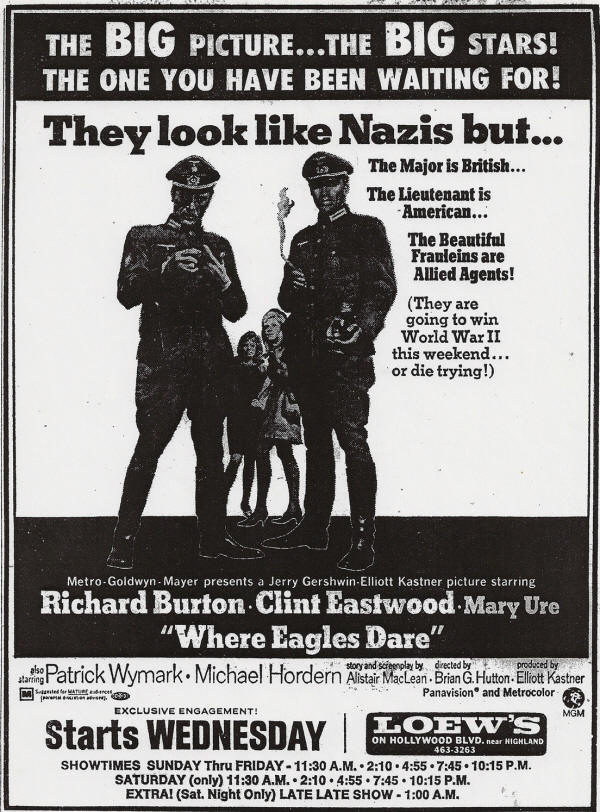 Advert
from the Los Angeles premiere. Advert
from the Los Angeles premiere.Realism is the sinc qua non of today's films. With audiences growing more sophisticated all the time, the old artifices of Hollywood are less and less acceptable. If a couple is shown embracing on the quays of the Seine, nothing but a location shot beside the Seine will do. If snow is to fall lightly around the couple as they embrace, it had better get their faces wet or audiences will scoff. This new awareness on the part of moviegoers places the greatest burden on the action-adventure genre in which on-screen heroism has always been helped along by time-honored off-screen techniques. Now things are different. Though a certain amount of studio work is inevitable, today's major film production must go where the action is. Thus, when producer Elliott Kastner and director Brian Hutton were preparing to film MGM's "Where Eagles Dare," an action-packed story of a World War II parachute mission into the Alps, written directly for the screen by novelist Alistair MacLean, the choice was obvious. It had to be filmed in the Alps in the dead of winter. Logistically, the problems of mounting a big-budget motion picture are legion. But when such a film is to be made halfway up an Austrian mountain in 20 degrees below zero weather and driving snowstorms, the enterprise makes Hercules' labors seem like child's play. "Where Eagles Dare," which stars Richard Burton, Clint Eastwood and Mary Ure, was made on location in Austria and Switzerland under exactly those conditions. MacLean's screenplay, the first original story he has ever written for the cinema, called for demolition on a grand scale. To be demolished, dynamited and/or destroyed by fire: eight buildings, four cable cars, ten trucks, seven airplanes, six automobiles, three jeeps, three motorcycles and one bridge. The demolition incurred off-screen by the "Where Eagles Dare" production unit proved almost as spectacular. Four fabulously expensive motion picture cameras were destroyed in the explosions. Several pieces of valuable technical equipment were lost in neck-deep snow drifts. A giant truck carrying the arc-lights skidded on an icy mountain road and overturned, spilling its cargo down a snow-covered slope. Six actors were injured in the rough-and-tumble action. There were three cases of frostbite. And both producer Elliott Kastner and director Brian Hutton had their clothing set afire by flying debris from a blast. In the pursuit of greater realism the actors fought an epic fist fight on the ice-covered roof of a cable car swinging some 1,500 feet over the Alps. Others had to leap 75 feet from another cable car into a bone-chilling Alpine river. As Kastner says, "I'm sure that what we went through to make this picture will be strikingly obvious on the screen. It is a story of high adventure on both sides of the camera." |
|
Fire foam fools mother nature! |
|
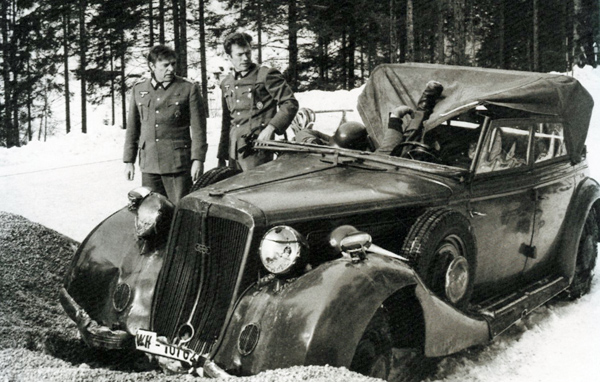 A specially rigged car crash involving stars Richard Burton and Clint
Eastwood for MGM's adventure-drama, "Where Eagles Dare," brought two
unscheduled ambulances at breakneck speed to the Austrian mountain location
outside Salzburg. A passer-by had seen the crashed car and its occupants
sprawling on the road but had not been aware of the film crew hidden behind
the bend, and had phoned for aid! Picture: MGM A specially rigged car crash involving stars Richard Burton and Clint
Eastwood for MGM's adventure-drama, "Where Eagles Dare," brought two
unscheduled ambulances at breakneck speed to the Austrian mountain location
outside Salzburg. A passer-by had seen the crashed car and its occupants
sprawling on the road but had not been aware of the film crew hidden behind
the bend, and had phoned for aid! Picture: MGMIt's a long, long time from May to September--and just as long from January back to May. So an adventure-minded movie location troupe recently discovered in the Austrian Alps. It was in January, amid sub-zero weather and blizzards, that filming began on snow-covered mountainsides and in various Alpine villages for MGM's new epic-action motion picture, "Where Eagles Dare." The film, starring Richard Burton, Clint Eastwood and Mary Ure, wrapped up its lengthy location in bright May sunshine and temperatures in the 70's. The trouble was that the Alistair MacLean screenplay for "Where Eagles Dare" covered exactly 24 hours from the moment an Allied team parachutes onto a meadow of unbroken snow behind World War II enemy lines. So the deep snow (by now melted) still had to be there for the picture. However, ingenious movie-makers, accustomed to having to improvise, weren't to be foiled either by a film script or by Mother Nature. They hired a crack Austrian fire-fighting crew, complete with fire engines, long-reaching ladders and pumping machines, to spray trees and hillsides with liquid foam, the same used for fighting fires. Then they trucked in as much as 1,000 tons of real snow a day from higher reaches of the Alps. And, finally, they touched off their man-made snow setting with Epsom salts, sometimes 50 tons per day. |
|
Richard Burton's fantastic fight atop cable car staged thousands of feet in the air for "Where Eagles Dare"! |
|
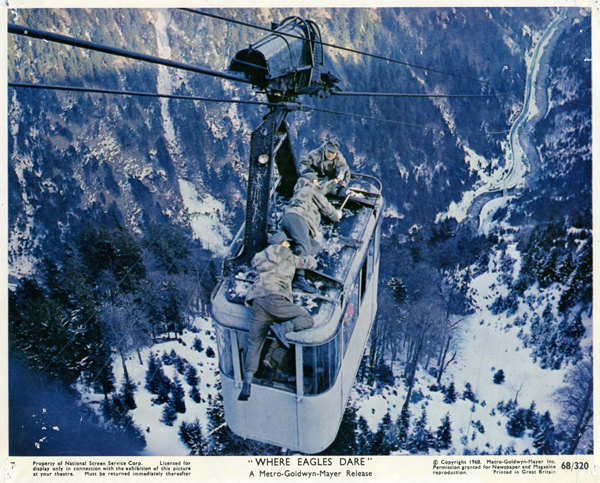 Richard Burton's fantastic fight atop cable car
staged thousands of feet in the air for "Where Eagles Dare"!
Richard Burton in his most exciting action-role in MGM's "Where Eagles
Dare." Burton plays the leader of an Allied team parachuted into the
Bavarian Alps behind enemy lines during World War II, with Clint Eastwood
and Mary Ure as fellow-adventurers. Filmed from a story and screen-play by
Alistair MacLean, the explosive drama was photographed on spectacular
locations in the Austrian Alps in Panavision and Metrocolor. Picture: MGM Richard Burton's fantastic fight atop cable car
staged thousands of feet in the air for "Where Eagles Dare"!
Richard Burton in his most exciting action-role in MGM's "Where Eagles
Dare." Burton plays the leader of an Allied team parachuted into the
Bavarian Alps behind enemy lines during World War II, with Clint Eastwood
and Mary Ure as fellow-adventurers. Filmed from a story and screen-play by
Alistair MacLean, the explosive drama was photographed on spectacular
locations in the Austrian Alps in Panavision and Metrocolor. Picture: MGMAt the bottom of the long cable car run, standing in driving snow, high in the Austrian Alps, the young American film producer said to the grizzled, burly man at his side: "Now, what we want to do is film a fight on top of that cable car as it goes up. Then we want to do another scene where our heroes jump off the car as it comes down and land in that river below. And, finally, we want to blow up the cable car and the station here. Can you do it?" Seventy-two-year-old Yakima Canutt, five times a grandfather and something of a legend in film circles, shifted his mouthful of chewing tobacco, then responded as he had to other movie producers before Elliott Kastner. "Just give me the time - and the money. Nothing is impossible." The fact that the fight atop a swinging cable car, for MGM's big adventture-drama, "Where Eagles Dare," would have to be staged thousands of feet in the air and in the midst of Europe's stormiest winter in years didn't appear to bother Canutt. It was for just such "impossible" accomplishments that he was awarded Hollywood's "Oscar." The wording was "for creating bigger and better stunt thrills in motion pictures," a unique profession he has pursued for more than 20 years. During that period Canutt has staged such memorable movie action as the chariot races in "Ben-Hur," the Clark Gable-led gorilla hunt in "Mogambo." John Wane's western fights in "Stagecoach" and the battles of such films as "Spartacus," "Ivanhoe," "El Cid" and many others. He feels he may have topped even himself with "Where Eagles Dare." The new picture, written by noted novelist Alistair MacLean and starring Richard Burton, Clint Eastwood and Mary Ure, brought other challenges in addition to the cable car caper. Producer Kastner also called on Canutt to blow up a railway station and a bridge, fire an ancient Austrian castle (without leaving it permanently scarred) and land parachutists in an incredible snow storm. Canutt, however, has lived a lifetime of thrills. He was a world champion rodeo cowboy continuously from 1917 through 1923 and holds fire world title belts as "all-round" cowboy. Then he became a silent-day western star in the era of such western idols as Buck Jones and Tom Mix, Hoot Gibson and Ken Maynard. "I starred in about 40 westerns before the talkies came along," he recalls. "They ended a lot of acting careers, including mine. I didn't have the voice for it." It proved a blessing in disguise for Canutt. He became a stunt man and began creating action and developing equipment that would make it possible to bring the most spectacular scenes to movie screens. Canutt worked as a stunt man until he was 50, a remarkable age for this dare-devil occupation. "The great thing for me was that it gave me the experience of working with writers and putting more action in their scripts," he says. "Before long producers began telling their directors, 'Don't worry about the action, old Yak will take care of that.'" |
|
Richard Burton Accepted Adventure Role On The Urging Of His Two Sons |
|
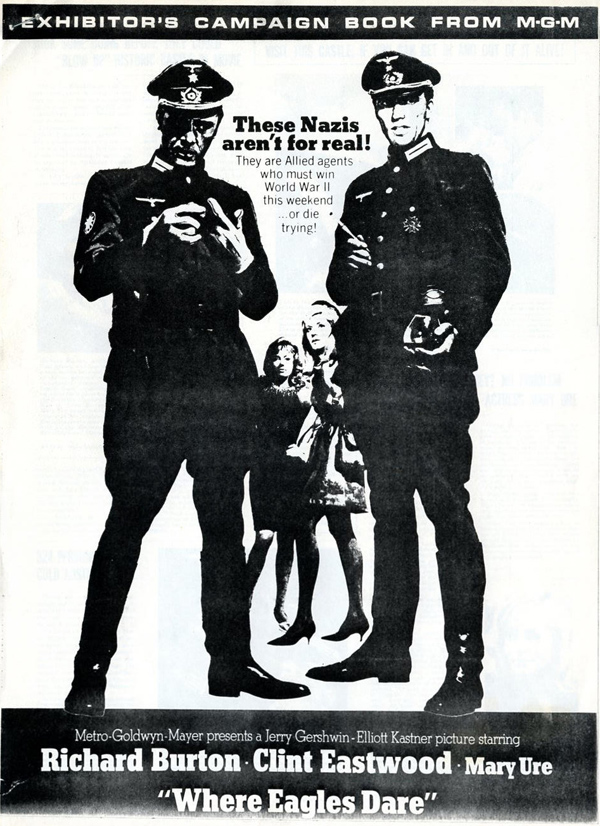 Richard Burton, with enough movie scripts offered him to keep him busy for
the next ten years if he were able to accept them all, credits his two sons
for his current role. Richard Burton, with enough movie scripts offered him to keep him busy for
the next ten years if he were able to accept them all, credits his two sons
for his current role.On location in the Austrian Alps for MGM's "Where Eagles Dare," the actor was asked how he happened to select this picture among all those submitted. His action role, as the adventurous leader of an international group parachuted behind the lines into World War II Germany, is in striking contrast to his portrayals in such films as "The Comedians," "Taming of the Shrew " "Who's Afraid of Virginia Woolf?" and "Boom!" With wife Elizabeth Taylor at his side throughout the filming in Austria, Burton recalled, "After they had seen 'Becket' and 'The Spy Who Came in from the Cold' my two boys asked me, 'Why do you always get killed? Why don't you do a picture in which you do the killing?' "A few nights later, I happened to meet Elliott Kastner, the producer, at a dinner party in Rome. I told him what the boys had said and asked him if he didn't have a story like that." Kastner didn't at the moment, but with a star like Burton interested, he didn't waste any time in doing something about it. Kastner caught the next plane to London and telephoned Alistair MacLean, generally regarded as today's No. 1 adventure novelist. He requested a meeting with MacLean. The best-seller author, whose "Guns of Navarone" and "Ice Station Zebra" were big film hits, said he didn't want to waste either Kastner's time nor his own. "All my novels except one already have been sold for films," he explained, "and the unsold one is considered to be too expensive to make into a movie." "But I don't want to buy the rights to one of your books," Kastner said. "I would like you to write a story directly for the motion picture screen for Richard Burton." As Kastner remembers it, there was a long silence on the phone. Then MacLean said, "You know, nobody ever asked me to do that before." They met the following day and six months later MacLean delivered his first original screenplay. Producer Kastner and star Burton were quick to approve it and preparations were begun immediately for the filming. Subsequently, MacLean transformed his screenplay for "Where Eagles Dare" into his latest best-selling novel. When the picture was completed, Richard Burton's two boys had their wishes fulfilled. MacLean saw to it that Burton lives at the end and also gets to knock over quite a number of the enemy en route! |
|
Alistair Maclean writes his first thriller directly for the screen |
|
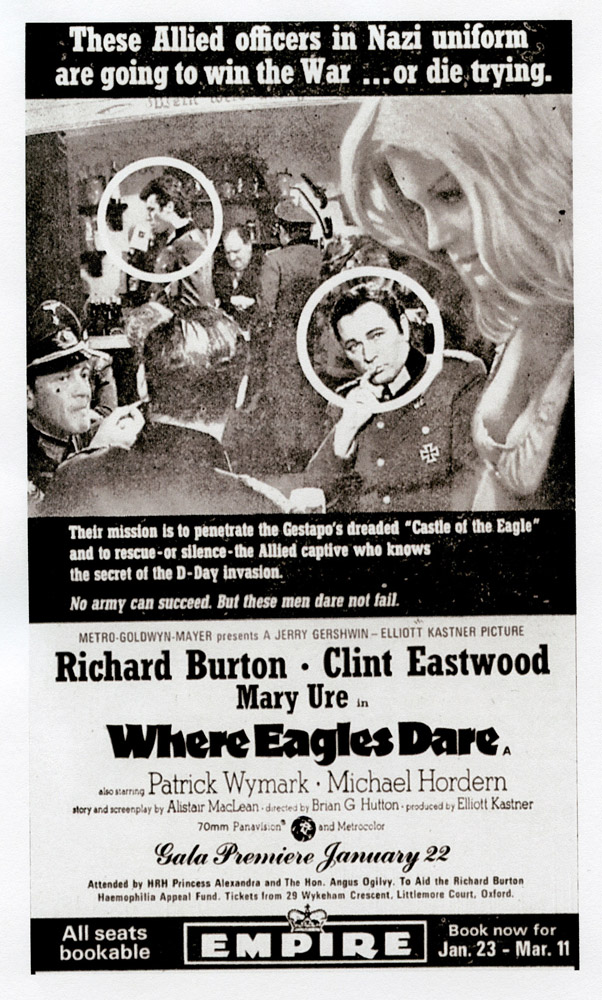 Release
at the Empire,London (UK), 22.01.1969 - 11.03.1069 Release
at the Empire,London (UK), 22.01.1969 - 11.03.1069Machine gun fire threatened to shatter the eardrums. Men in German, World War II vintage uniforms ran pell-mell and dropped right and left. When quiet returned, director Brian Hutton called, "Cut. Print it." Richard Burton and Clint Eastwood, still carrying their smoking schmeissers at their sides, stepped gingerly over the "bodies" and approached a diminutive wisp of a man standing inconspicuously on the sidelines of the London sound stage of MGM's adventure-drama, "Where Eagles Dare." "You wrote it, Alistair. Now you can get an idea of what you've put us through," said Burton, greeting the visitor. Alistair MacLean, appearing anything but the image one might conjecture of the day's foremost author of hair-raising adventure stories, responded with an embarrassed shrug. A notoriously shy man and self-depreciating in words and manner, MacLean looks more the schoolteacher he was until beginning to write his bestselling thrillers twelve years ago. Until recently, he hadn't given an interview in eight years. His unwillingness to participate in promotion of his novels is a frustration to book-dealers for whom he has been a hottest-selling author for years. His appearance on the MGM film set, where Burton and Eastwood were shooting up a small army of Nazis, was a rare occasion. It was due chiefly to his friendships with Burton and Elliott Kastner, producer of the Panavision and color film. It was Kastner who persuaded MacLean to write his first screenplay as an original for "Where Eagles Dare" and tailor it to Burton. MacLean has since transformed his movie script into novel form for his latest best-seller. "If possible, I will continue to write the screenplay first and then do the novel." he said. "I prefer doing it that way. There isn't any reason the screenplay shouldn't come before the book, is there?" Since breaking the ice with "Where Eagles Dare." MacLean has written two more original screenplays for Kastner. "One is a Caribbean pirate story, the other a western, but with no Indians and no horses," MacLean explained. "After all, I know nothing about the West. This story takes place on a train in the West." MacLean is as fast as he is prolific as a writer. One reason may be is that he insists upon keeping uninterrupted "office hours" at his typewriter from 8:30 a.m. to 5:30 p.m. daily. He wrote his screenplay for "Where Eagles Dare" in just six weeks. In the picture, Burton leads an international team on an incredible mission into World War II Germany. The group, including Clint Eastwood as the American officer, and Mary Ure as its lone feminine member, is parachuted onto a snow slope high in the Austrian Alps. Through raging blizzards, they make their way into a village training quarters for the crack Nazi Alpenkorps, and from there attempt to infiltrate an impregnable "castle of the eagle" in order to rescue a top American general. When Burton and Eastwood described the seven weeks of rugged filming his story had required amid snow storms and sub-zero temperatures in the Alps, MacLean shrugged again. When they mentioned the obvious astronomical cost of the filming under such conditions and with a troupe of more than 300 persons, his response was typically brief. "For my Scottish soul, that must have cost a lot of money." |
|
Ingrid Pitt's real-life saga would make a movie-thriller in itself! |
|
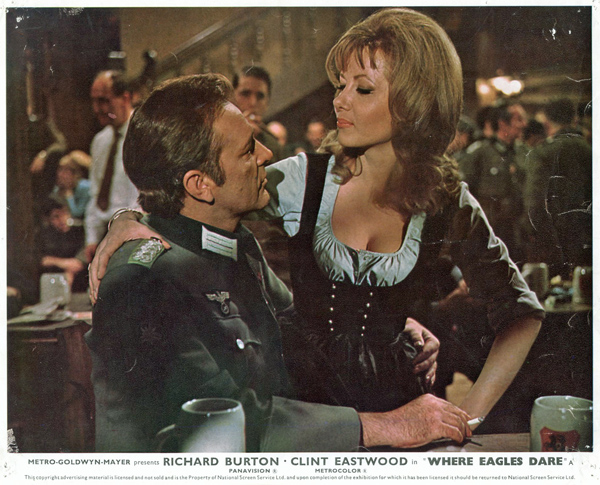 Ingrid Pitt adds to the excitement of MGM's "Where Eagles Dare" in the
role of a beautiful conspirator who aids Richard Burton, Clint Eastwood and
Mary Ure in a danger-filled Allied mission behind German lines during World
War II. Filmed from a story and screenplay by Alistair MacLean, the
explosive adventure-drama was photographed on spectacular locations in the
Austrian Alps in Panavision and Metrocolor. Picture: MGM Ingrid Pitt adds to the excitement of MGM's "Where Eagles Dare" in the
role of a beautiful conspirator who aids Richard Burton, Clint Eastwood and
Mary Ure in a danger-filled Allied mission behind German lines during World
War II. Filmed from a story and screenplay by Alistair MacLean, the
explosive adventure-drama was photographed on spectacular locations in the
Austrian Alps in Panavision and Metrocolor. Picture: MGMIngrid Pitt is a shoulder-length blonde with an impressive bust, high-speed hips and a way of talking that makes you want to get closer. A certain cultivated naivete is part of her charm, too. Elliott Kastner, the producer of MGM's World War II adventure drama, "Where Eagles Dare," found he couldn't turn her down for the part of the luxurious barmaid-cum-spy called Heidi. Even so, 299 other actresses had to suffer the audition don't-call-us-we'll-call-you verdict before Ingrid won the opportunity to appear before the Panavision and color cameras with stars Richard Burton, Clint Eastwood and Mary Ure. During filming on locations in and around Salzburg, Austria, Miss Pitt was subjected to sub-zero temperatures, a thrill-a-second Alpine bus ride, explosions and hordes of pursuing German troops bearing flaming schmeissers (they're like sten guns). In later scenes she was interrogated by the gestapo. All of which was kindergarten training compared with Ingrid Pitt's real-life flight to freedom from East Germany. In 1963, she was working in the Eastern sector when the wall went up. She walked to the border, went up to the Vopos (East German frontier guards at the Berlin Wall) and momentarily disconcerted them with the simple plea, "Please let me go." She then stepped out smartly across the frontier bridge. "When the guards regained their senses, they began firing," Ingrid recalls, "but they must have deliberately aimed wide. I was waiting for a sudden bullet in the back." She got halfway across the bridge, then leaped into the water, swam to the west side and was pulled out by an American Army patrol. Like all heroines, Ingrid promptly fainted after the ordeal. After six months of modeling in West Berlin and a further two years doing the same thing in New York, where she lived with her elder sister, Brigette, a painter, Miss Pitt was eager to make another escape bid--this time an escape from monotony. She walked to a second-hand car lot, bought a 1949 Oldsmobile and set out on what became a 20,000-mile round trip through Colorado, Arizona, Texas, Georgia and on and on. She followed the pack trails to dude ranches and roamed far and wide wherever adventures dictated. Then she abandoned the Oldsmobile for the "luxury" of riding on horseback accompanied by twelve silent Indians into and out of the Grand Canyon. "We journeyed for 14 hours," Miss Pitt relates, "and they spoke not one word during the entire time." She completed the trip on a Mississippi steamer, returned to New York and then, with sister Brigette, flew to Madrid. Here she met a newspaper man who introduced Ingrid to Anna Mariscal, a noted actress turned film director. It was a fortunate introduction for the latter gave Miss Pitt the leading role in her latest movie. "I thought that kind of thing belonged to fairy tales," she says, "but then, I always seem to get involved in the most unlikely events." Truer words were never spoken by this unconventional young actress! |
|
Kiss--Pinch--Slap! |
|
|
Playing a key role with Richard Burton in her first major motion picture,
MGM's "Where Eagles Dare," was "a dream come true" for German beauty Ingrid
Pitt. But she's not so sure about her first scene with the actor. It called for a kiss, then a pinch (both delivered by Burton) and then a slap, delivered by Miss Pitt. "I really hated to hit him," she said, after the scene was completed. "I have always admired him so much." All in all, it was quite a debut in the movie big-time for the girl who once swam the River Spree from East Berlin to find freedom in the West. Next to that, this was her biggest thrill--even with the slap! |
|
Where Richard Burton Goes On Movie Location, There Is Elizabeth Taylor |
|
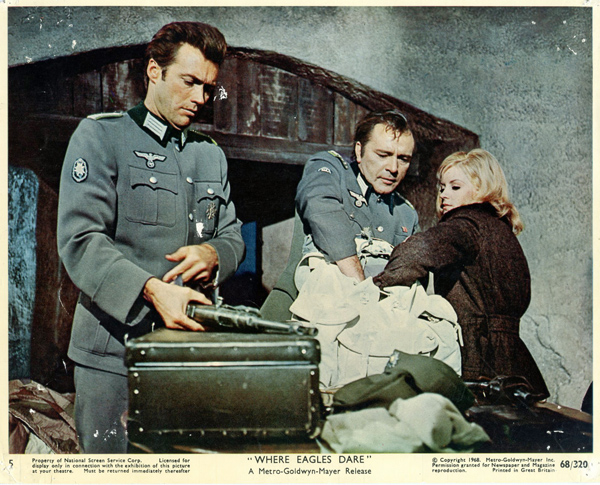 Clint
Eastwood, Richard Burton and Mary Ure enact fellow-conspirators in MGM's "Where
Eagles Dare," explosive drama of an Allied team parachuted into the Bavarian
Alps behind enemy lines during World War II. Clint Eastwood also adds to the
excitement of the thrill-packed picture, filmed from a story and screenplay
by Alistair MacLean and photographed on locations in the Austrian Alps in
Panavision and Metrocolor. Picture: MGM Clint
Eastwood, Richard Burton and Mary Ure enact fellow-conspirators in MGM's "Where
Eagles Dare," explosive drama of an Allied team parachuted into the Bavarian
Alps behind enemy lines during World War II. Clint Eastwood also adds to the
excitement of the thrill-packed picture, filmed from a story and screenplay
by Alistair MacLean and photographed on locations in the Austrian Alps in
Panavision and Metrocolor. Picture: MGMA few eyebrows were raised in Salzburg, Austria, when Elizabeth Taylor accompanied husband Richard Burton to Salzburg from their lavish home in Switzerland, and then remained at his side on long drives through raging storms and on freezing treks up snow-covered mountains. Burton had no choice in the matter since he was starring in MGM's adventure-drama, "Where Eagles Dare," and a good part of the action was being filmed in Austria. But during one of her rare "holidays" between roles, the glamorous Liz could have chosen to relax comfortably at home. However, as the surprised Austrians were quick to discover, they just didn't know the Burtons. "In six years we've been apart only eleven days," Burton explained, during a lull between scenes on a high slope above the Alpine village of Werfen. "Once her father was ill and she few to California to be with him. The only other time was when she was away to attend the funeral of our chauffeur's son. I was working in films both times and couldn't get away." The "togetherness" of the fabulous Burtons was constantly evident when they hobnobbed with the rest of the "Where Eagles Dare" troupe at their hotel in Salzburg. When a fellow worker asked Burton if he had any time for hobbies, he replied, "Yes, two. Reading and looking at my wife." Elizabeth turned down a tempting role in order to be with her husband throughout the filming of "Where Eagles Dare," a picture that excites him for the change of pace it offers. The film, which also stars Clint Eastwood and Mary Ure, is his first action-adventure picture in years and a sharp contrast to "Taming of the Shrew," "The Comedians," "Who's Afraid of Virginia Woolf?" and "Boom!" |
|
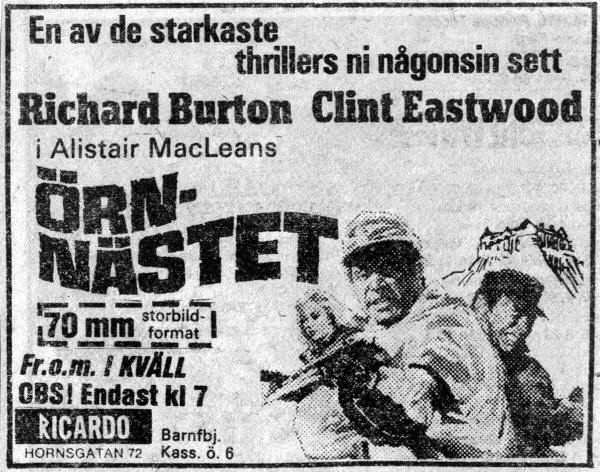 "The Eagles Nest" was
a very successful 70mm release in Sweden. "The Eagles Nest" was
a very successful 70mm release in Sweden."I know the Welsh will love it," said Burton, whose father and six brothers were miners in Wales. "They'll like the excitement and color. It's pure entertainment on an epic scale and I had the time of my life playing the kind of chap heroes dream about." In the story, written for the screen by novelist Alistair MacLean, Burton plays the leaders of an international team dropped by parachute into Germany on an incredible mission on which the success of the Allied landing of World War II depends. He and his partners, including Eastwood and Miss Ure, not only battle the elements and the terrain, but the cleverest brains of the Gestapo and the stoutest guns of the enemy. Burton (and Liz) put in a typical day on location that went something like this: At 7:30 a.m., Burton reported for make-up in Salzburg's Hotel Osterreichischer. His wife joined him shortly after and while he was being made up, they went over a daily mound of correspondence, invitations, business matters and the day's program. Present also were three secretaries and sometimes a business associate and publicity man. An hour later, they left for the film location at one of three major bases, the villages of Werfen, Lofer or Ebensee. If the base were Werfen, they would transfer from their limousine after an hour's drive into a mini-bus, which carried them up a steep, winding, one-way road. There, at a second base camp, they would change to a jeep to be driven another more difficult two miles. Finally, to reach the filming site they walked through deep snow for another several hundred yards. |
|
Director Hutton On Problems Of Filming Thrills |
|
 English
actor Derren Nesbitt plays Major von Hapen in Where Eagles Dare" in
Bradford, 2009. Picture: Thomas Hauerslev English
actor Derren Nesbitt plays Major von Hapen in Where Eagles Dare" in
Bradford, 2009. Picture: Thomas HauerslevExcept for Elizabeth Taylor, they came to ski. Instead, visitors to Austria's famed snow resort at Ebensee recently were startled to see: Three men fighting wildly atop an Alpine cable car as it swung precariously 1,000 feet in the air.... Four people leap from a cable car into a river some 70 feet below.... The same car, moments later, explode and crash in pieces to the ground. The would-be skiers found Ebensee virtually turned upside-down and no way available for them to reach the coveted high slopes above. But they found other compensating interests. In Ebensee's cosy little inn and on its narrow, icy streets they had an opportunity to mingle with stars they'd only been privileged to see before on motion picture screens. Like them, Elizabeth Taylor was a visitor on vacation. But her husband, Richard Burton, along with Clint Eastwood, Mary Ure and a dozen featured players were on hand to work. As the stars in an unusually large motion picture troupe, sometimes numbering as many as 324, Burton, Eastwood and Miss Ure were in Ebensee and other parts of the Austrian Alps to film MGM's adventure-drama, "Where Eagles Dare." It was a moot question as to which proved the greater fascination - the proximity of such celebrities or the incredible action involving, among other things, the cable cars. The film story, written by noted novelist Alistair MacLean ("The Guns of Navarone," "Ice Station Zebra"), follows the heroics of an Allied team parachuted into the Bavarian Alps behind Enemy Lines during World War II. Its objective is an impregnable Nazi castle-fortress, reached only by cable car. To make possible some of the story's spectacular scenes, stunt men worked at times in the most dangerous conditions of their danger-packed careers. |
|
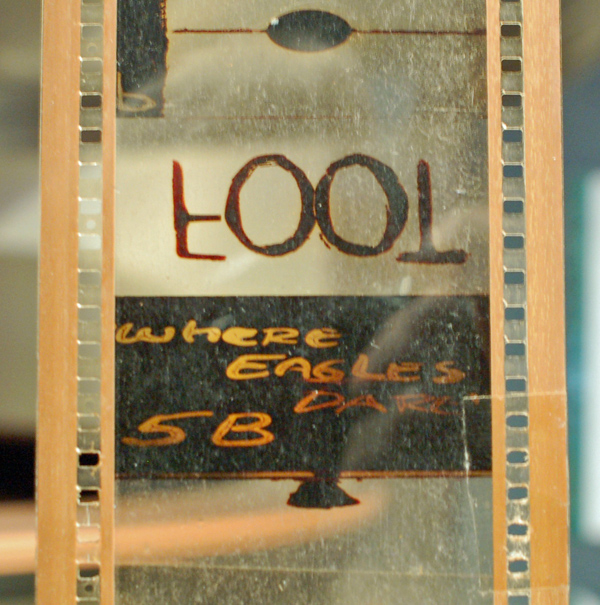 60-Mile-an-Hour Winds
Picture: Thomas Hauerslev 60-Mile-an-Hour Winds
Picture: Thomas Hauerslev"There were occasions when they were in 60-mile-an-hour winds on top of that car," declared Brian Hutton, the director of "Where Eagles Dare." "Often they were working without protective life lines. They took unbelievable risks. They knew that if they should lose their footing and drop over the side, there'd be no use sending an ambulance. "We insisted on every precaution possible, which is probably why we escaped without injury or worse. But these stunt men seem to scoff at too many precautions, as though they were a reflection on their professional ability." The biggest problem encountered, according to Hutton, was the locationing of cameras to photograph the action in Panavision and color. The two cable cars on the Ebensee run travel nearly two miles to a peak over a mile high. The various movie scenes were filmed at spots along the entire run. "We hung cameras under, over and around one car in just about every manner conceivable," said Hutton. "Some scenes were filmed from a platform spread wing-like over a car. Sometimes our camera crew was right on top of the moving car with the fighting stunt men." Still other mounts for the camera were found on towering pylons, supporting the cable at intervals; on a tiny, two-man rescue car and on a mechanized platform designed to run parallel to the car in a scene. As many as six cameras were used at one time, and two full crews were involved in the filming. Directing the second unit was Yakima Canutt, a veteran of movie action sequences. The exploding of a car called for special precautions to safeguard equipment rather than human life. "The main concern was the heat generated by an explosion, since there was danger of its weakening the cable," explained Hutton. "We wrapped the cable in asbestos and had thermometers taped to it directly above the explosion point to check the heat. We weren't permitted to so much as drill a hole in one of Ebensee's regular cars and had to build a duplicate car to destroy." |
|
 • Go to MGM Exhibitor's Campaign Book "Where Eagles Dare", 1968 |
|
| Go: back - top - back issues - news index Updated 22-01-25 |
